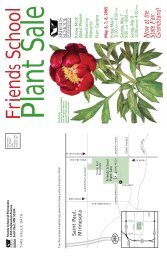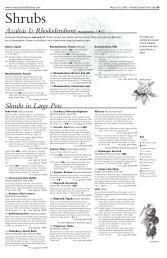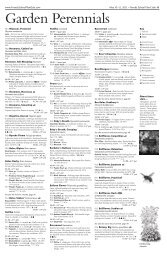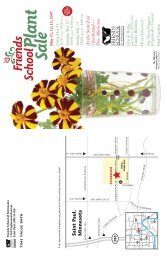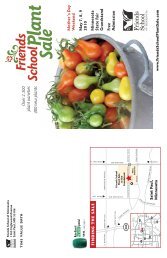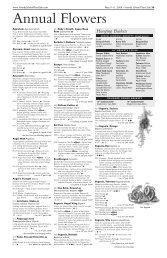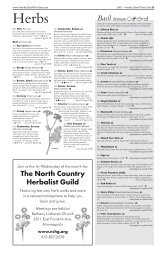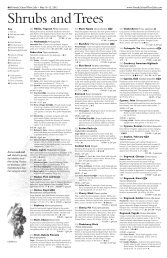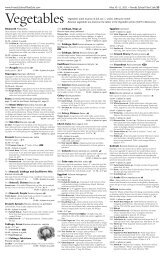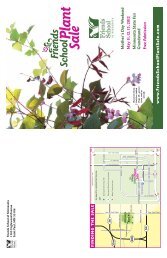View the 2013 56-page PDF here - Friends School Plant Sale
View the 2013 56-page PDF here - Friends School Plant Sale
View the 2013 56-page PDF here - Friends School Plant Sale
You also want an ePaper? Increase the reach of your titles
YUMPU automatically turns print PDFs into web optimized ePapers that Google loves.
www.<strong>Friends</strong><strong>School</strong><strong>Plant</strong><strong>Sale</strong>.com May 10–12, <strong>2013</strong> • <strong>Friends</strong> <strong>School</strong> <strong>Plant</strong> <strong>Sale</strong> 17<br />
Garden Perennials<br />
We accept cash, checks, Amex,<br />
Visa, MasterCard & Discover<br />
P286 Hen and Chicks, Chinese ◊<br />
Orostachys iwarenge<br />
Curious 6” cones rise from a mat of miniature peachblue-gray<br />
rosettes. When <strong>the</strong> cones flower with tiny<br />
pink-white blossoms in fall, <strong>the</strong> mo<strong>the</strong>r plant fades<br />
away leaving numerous tiny plantlets on short thin<br />
“apron strings.” Recently discovered in China. May<br />
want some winter mulch. 3–6”h Í $3.00—2.5” pot<br />
Hibiscus Hibiscus moscheutos<br />
Dinner plate blooms. Breaks dormancy very late; mark<br />
<strong>the</strong> spot so you don’t dig it up by mistake. Remarkably<br />
easy to grow and fast blooming, giving months of<br />
breathtaking pleasure. Í´Â<br />
$1.50—2.5” pot:<br />
P287 Disco Belle Mix ß—Red, pink or white. 25”h<br />
$4.00—2.5” pot:<br />
P288 Pink Clouds—Intense deep-pink flowers. Robust<br />
and blooms over a long period. Maple-shaped<br />
leaves. 48–60”h<br />
$6.00—1 quart pot:<br />
P289 Luna Red ß—Dramatic 7–8” red flowers bloom<br />
late summer to fall; heat and drought tolerant<br />
once established. 24–36”h<br />
P290 Pink Swirl ß—Huge, 8” blooms swirl open to<br />
reveal brush strokes of pink, rose and cranberry<br />
on bright white petals. 24–30”h<br />
See also <strong>the</strong> TROPICAL HIBISCUS, <strong>page</strong> 36<br />
Hollyhock Alcea<br />
Old-fashioned, towering spires of big blossoms resembling<br />
ruffled petticoats evoke memories of “Grandma’s<br />
garden.” Most are biennial, but reseed for perennial<br />
effect. Í´˙<br />
$1.50—2.5” pot:<br />
P291 Chater’s Double Mix, A. rosea ß—72”h<br />
P292 Chater’s Royal Purple, A. rosea ß—Large 3-5”<br />
deep purple fully double ruffled blooms. Blooms<br />
first year if planted early. 60–72”h<br />
P293 Fig leaf, A. ficifolia ß—Single blooms in light<br />
pink to rose to fuchsia. Perennial. 96”h Ω<br />
P294 Indian Spring, A. rosea ß—Old-fashioned singles.<br />
in rose, pink and white. 60”h Ω<br />
P295 Powderpuffs, A. rosea ß—Double pastel flowers.<br />
48”h<br />
$2.00—2.5” pot:<br />
P296 Peaches ’n’ Dreams, A. ficifolia ß—Enormous<br />
flowers change color with age, two tones at once,<br />
from peachy-yellow to raspberry pink. The most<br />
cold tolerant of <strong>the</strong> double hollyhocks. Perennial.<br />
48–72”h<br />
$2.50—2.5” pot:<br />
P297 Russian Hollyhock, A. rugosa—Radiant light yellow.<br />
Single blooms May to September. Perennial.<br />
48–84”h Ω<br />
$3.00—3.5” pot:<br />
P298 The Watchman, A. rosea nigra ß—Blackish<br />
maroon singles. 72”h Ω<br />
Hollyhock, French Malva sylvestris<br />
An unfussy, vintage plant grown by Thomas Jefferson<br />
at Monticello. Considered biennial to short-lived<br />
perennial, but can be treated as reseeding<br />
annuals.Rabbit resistant and drought tolerant. Í<br />
$3.00—2” pot:<br />
P299 Purple Satin—Grape with darker purple veins,<br />
<strong>the</strong> 2.5” flowers bloom all summer. 36–48”h<br />
$3.00—3.5” pot:<br />
P300 Zebrina ß—White with purple veining. 48”h<br />
Hosta see <strong>page</strong> 16<br />
Hummingbird Mint Agastache<br />
As <strong>the</strong> name says, <strong>the</strong>se mint relatives attract hummingbirds.<br />
Also goldfinches, bees, and butterflies.<br />
Requires good drainage, particularly in winter. Don’t<br />
cut back fully until spring so that <strong>the</strong> crown can’t collect<br />
water. Deer resistant. Í∏∫Ω˙<br />
$1.50—2.5” pot:<br />
P355 Hea<strong>the</strong>r Queen, Texas Hummingbird Mint, A.<br />
cana ß—Sweet-minty foliage and brilliant purplish-rose<br />
flower masses late in summer when<br />
few perennials are in bloom. Loves heat and is<br />
drought tolerant. 30”h<br />
$2.00—2.5” pot:<br />
P3<strong>56</strong> Blue Fortune, A. rugosa x A. foeniculum ß—One<br />
of <strong>the</strong> earliest varieties. Long bloomer with lavender-blue,<br />
bottlebrush flowers on upright stems,<br />
mid-summer to fall. 36–48”h<br />
$3.00—2.5” pot:<br />
P357 Coronado Red, A. aurantiaca—Spikes of cheery<br />
orange tubular flowers from midsummer to frost.<br />
Silvery leaves make a nice contrast and are<br />
intensely aromatic. A tough plant for hot, moderately<br />
dry areas with well-drained soil. 15–24”h<br />
Hummingbird Mint continued<br />
$6.00—4.5” pot:<br />
P358 Bolero, A. cana x A. barberi ß—Licorice-scented<br />
deep bronzy foliage contrasts dramatically with<br />
<strong>the</strong> rosy purple flowers. Long bloomer. 16”h<br />
See also <strong>the</strong> annual HUMMINGBIRD MINT, <strong>page</strong> 36<br />
Ice <strong>Plant</strong>, Hardy Delosperma<br />
Low-growing succulent ground cover from South<br />
Africa. Protect from winter wetness. Drought tolerant<br />
and deer resistant. Í˝<br />
$3.00—2.5” pot:<br />
P359 Fire Spinner—Cheery little orange and magenta<br />
daisies cover <strong>the</strong> mat of foliage like something<br />
you’d find under <strong>the</strong> sea on a coral reef. Blooms<br />
abundantly in late spring and <strong>the</strong>n throughout<br />
<strong>the</strong> summer. 2–3”h by 24–36”w<br />
$6.00—4.5” pot:<br />
P360 Ice <strong>Plant</strong>, D. nubigenum—Bright yellow-green<br />
foliage that turns reddish in <strong>the</strong> fall, with single<br />
yellow ray flowers beginning in May. Requires<br />
sandy soils and a hot sunny location. 4”h ‰<br />
Indigo, Wild Baptisia australis<br />
A classic garden favorite with pea blossoms and graygreen<br />
foliage. Blooms in June. Black seed pods later in<br />
<strong>the</strong> season are good for dried arrangements. Snubbed<br />
by deer. Tolerates poor, dry soil. Does not transplant<br />
once established. 2010 Perennial <strong>Plant</strong> of <strong>the</strong> Year.<br />
Í∏ Ω∫¥<br />
$1.50—2.5” pot:<br />
P361 Blue, B. australis ß—One of <strong>the</strong> U of M’s Tough<br />
and Terrific perennials. ***** 36–48”h Â<br />
$3.00—2.5” pot:<br />
P362 Dwarf, B. australis minor—A miniature version of<br />
<strong>the</strong> classic garden favorite. ***** 15–24”h Â<br />
Decadence Series<br />
This new series, with each variety named for desserts,<br />
was painstakingly hybridized by Hans Hansen of<br />
Walters Gardens in Michigan to achieve spikes of<br />
uniquely colored blooms, dense branching, blue-green<br />
foliage, and compact size. Huge ornamental smoky<br />
seed pods follow <strong>the</strong> blooms. 36”h<br />
$10.00—4.5” pot:<br />
P363 Blueberry Sundae ◊ß— Deep indigo variety<br />
has more vibrant color than its parents.<br />
P364 Dutch Chocolate ◊ß—Lustrous velvet purple<br />
blooms with brown notes are <strong>the</strong> ultimate in<br />
sophistication. Black-purple buds. Even <strong>the</strong> lower<br />
stalks are covered with foliage.<br />
P365 Lemon Meringue ◊ß—Lemon yellow flowers<br />
against charcoal stems on a striking vaseshaped<br />
plant. 36”h<br />
See also <strong>the</strong> native WILD INDIGOS, <strong>page</strong> 50<br />
P366 Indigo, Yellow Thermopsis montana<br />
Yellow, lupine-like spring flowers in 4–12” clusters<br />
followed by velvety pods. 24–36”h Í∏ Ω¥<br />
$1.50—2.5” pot<br />
Iris, Bearded Iris germanica<br />
Easy to grow with May–June blooms. Clump-formers,<br />
best in groups. Cultivate iris shallowly. The top of <strong>the</strong><br />
rhizome should be exposed, so clean soil off <strong>the</strong>m in<br />
April to let <strong>the</strong> sun hit <strong>the</strong> rhizome. Highly drought<br />
tolerant; well-drained soil. Should be lifted and divided<br />
every few years. ͥ<br />
$4.00—3” plug:<br />
P367 Batik—Large royal purple flowers splattered and<br />
streaked with white flecks. Very striking. 35”h<br />
P368 Immortality—White with yellow beards. Blooms<br />
spring and repeats in fall. 36”h<br />
P369 Stairway to Heaven—Near white standards and<br />
round flaring medium blue falls. Wonderful<br />
wave-like ruffles. ***** 39”h<br />
$10.00—4.5” pot:<br />
P371 Hello Darkness ◊—Winner of <strong>the</strong> Dykes<br />
Medal in 1999 for its obsidian purple-black velvet<br />
ruffled blooms and licorice-anise scent. 36”h<br />
P372 Rip City ◊—Mulberry red ruffled blooms<br />
with gold beards that make it seem to glow from<br />
within. Well-branched with 10–13 buds per stem,<br />
giving it a long bloom time. 39”h<br />
P373 Iris, Copper Iris fulva<br />
Rust-colored Louisiana iris that will be happy in standing<br />
water or kept well-watered. Winter mulch.<br />
May–June blooms. 24–48”h Í $9.00—1 quart pot<br />
P374 Iris, Crested Iris cristata<br />
Low-growing, early-blooming woodland iris. Pale blueyellow.<br />
Sweet! 3–8”h Í∏Ó Ω¥ $3.00—2.5” pot<br />
P376 Iris, Dwarf Bearded Iris pumila<br />
What Again—Light lavender-blue standards and<br />
apricot-yellow falls, accented with icy blue beards.<br />
Reblooms. April–May bloom. 10–12”h Í∏¥<br />
$4.00—3” plug<br />
P377 Iris, Dwarf Wild Iris setosa canadensis<br />
Purple flowers accented with rich dark veins. Native to<br />
nor<strong>the</strong>astern U.S. and Canada. Summer bloomtime,<br />
prefers moist soil. Syn. Iris setosa nana. 12–15”h Í ‰¥<br />
$3.00—2.5” pot<br />
P378 Iris, Japanese Iris ensata variegata<br />
Large, flat purple flowers with green and cream leaves.<br />
Native to Japanese and Siberian pond edges, so it<br />
requires moisture, but will do well if watered regularly.<br />
28”h Í∏ ç¥ $3.00 each—in Bulbs & Bareroots<br />
Iris, Siberian Iris sibirica<br />
Blooms after <strong>the</strong> bearded iris, extending <strong>the</strong> iris season.<br />
Graceful, sword-like foliage. Native to moist areas,<br />
so moisture throughout <strong>the</strong> season is crucial to healthy<br />
plants. Excellent border plant. Í∏<br />
$5.00 each—in Bulbs & Bareroots<br />
P379 Pink Haze—Slightly ruffled lavender-pink with<br />
crimson veining and narrow white-rimmed falls,<br />
and a gold and burgundy blaze. Winner of <strong>the</strong><br />
American Iris Society’s highest award. Introduced<br />
1969. Blooms May to June. 24–36”h<br />
P380 Strawberry Fair ◊—Flared, strongly ruffled<br />
petals are raspberry with blue tones and marked<br />
like a peacock fea<strong>the</strong>r in green-gold, burgundy,<br />
white and blue at <strong>the</strong> base of each petal. Winning<br />
awards since first introduced 20 years ago.<br />
Blooms late in <strong>the</strong> Siberian iris season. *****<br />
24–36”h<br />
$6.00—1 quart pot:<br />
P381 Butter and Sugar ß—Bright butter-yellow falls<br />
between neat white standards. Reblooms. Large<br />
field-grown clumps. 28”h<br />
P382 Welcome Return ß—Velvet deep purple flower<br />
that reblooms. 24”h<br />
$6.00—4.5” pot:<br />
P383 Claret Cup ◊ß—Delicate red-wine flowers<br />
with white markings at <strong>the</strong> throat. 28”h<br />
P384 Shirley Pope ◊ß—Sumptuous velvety purple<br />
flowers with purple veined white signals. Foliage<br />
is distinctly dark green. 36”h<br />
P385 Silver Edge ◊ß—Startling sky-blue flowers<br />
with narrow white edging. 30”h<br />
P386 Super Ego ◊ß—Stately with wide flowers in<br />
light and dark blue with dark blue to purple veining.<br />
32”h<br />
$6.00 each—in Bulbs & Bareroots<br />
P387 White Swirl ◊—Wide, flared, ivory-white<br />
petals and falls with a touch of gold at <strong>the</strong> throat.<br />
30”h<br />
P388 Iris, Variegated Iris pallida ß<br />
Argentea—Lavender flowers early summer. Striking<br />
green and white striped sword-leaves throughout <strong>the</strong><br />
season. 24”h Í∏ ç¥ $10.00—1 quart pot<br />
See more IRIS, <strong>page</strong>s 6 and 50<br />
Jacob’s Ladder Polemonium<br />
Fernlike leaves with up to 20 neatly arranged “rungs”<br />
and an abundance of silky, cup-shaped flowers in any<br />
reasonably well-drained, humus-rich soil. Í∏Ó<br />
$1.50—2.5” pot:<br />
P389 Blue Master, P. foliosissimum ß—Long-blooming.<br />
Considered <strong>the</strong> best overall with 1” blue flowers<br />
with orange stamens. 30”h<br />
P390 Blue Pearl, P. caeruleum ß—Bright blue flowers.<br />
Prefers moist, cool conditions. 24–30”h<br />
$10.00—4.5” pot:<br />
P391 Bressingham Purple, P. yezoense—Striking deep<br />
purple-tinged foliage showcases deep blue flowers.<br />
Needs cool, moist, light shade. Foliage color<br />
most intense in spring and fall. 15”h ç<br />
See also <strong>the</strong> native JACOB’S LADDER, <strong>page</strong> 59<br />
P392 Jupiter’s Beard Centranthus ruber ß<br />
Clusters of small red flower blossoms; blooms <strong>the</strong> first<br />
season. Tolerates poor soil. 30”h Í∏Ó<br />
$1.50—2.5” pot<br />
P393 Lady’s Mantle Alchemilla mollis<br />
Thriller—Attractive edging ground cover or accent<br />
plant. Large silver-green rounded leaves that are scalloped<br />
and serrated hold tiny drops of water like little<br />
jewels. Clusters of tiny greenish-yellow star flowers in<br />
July. A staple of English gardens. 18” ***** Í∏Ó<br />
ç˝Â‰<br />
$1.50—2.5” pot<br />
P394 Lady’s Tresses, Fragrant<br />
Spiran<strong>the</strong>s cernua odorata<br />
Porcelain white 12" spires of small, sweetly scented<br />
flowers over 3–4" foliage on this North American<br />
native orchid. Long-lasting cut flower. Damp, compostrich<br />
soils preferred. 12” Í∏ $4.00—2.5” pot<br />
Key<br />
Í Full sun<br />
∏ Part sun/part shade<br />
Ó Shade<br />
Ω Good for bees<br />
ı Bird food source<br />
∫ Butterfly-friendly<br />
˙ Hummingbird-friendly<br />
ç Attractive foliage<br />
Ç Culinary<br />
´ Edible flowers<br />
˝ Ground cover<br />
 Medicinal<br />
˜ Minnesota native<br />
‰ Rock garden<br />
† Cold-sensitive:<br />
keep above 40°F<br />
¥ Toxic to humans<br />
ß Saturday restock<br />
About those<br />
stars…<br />
Throughout, you will<br />
notice plants that are<br />
marked with five stars<br />
(★★★★★). These plants<br />
have been awarded five<br />
stars by Heger and<br />
Whitman in <strong>the</strong> 2011<br />
edition of Growing<br />
Perennials in Cold Climates<br />
as one of <strong>the</strong> very best<br />
plants available on <strong>the</strong><br />
market.<br />
Hollyhock





